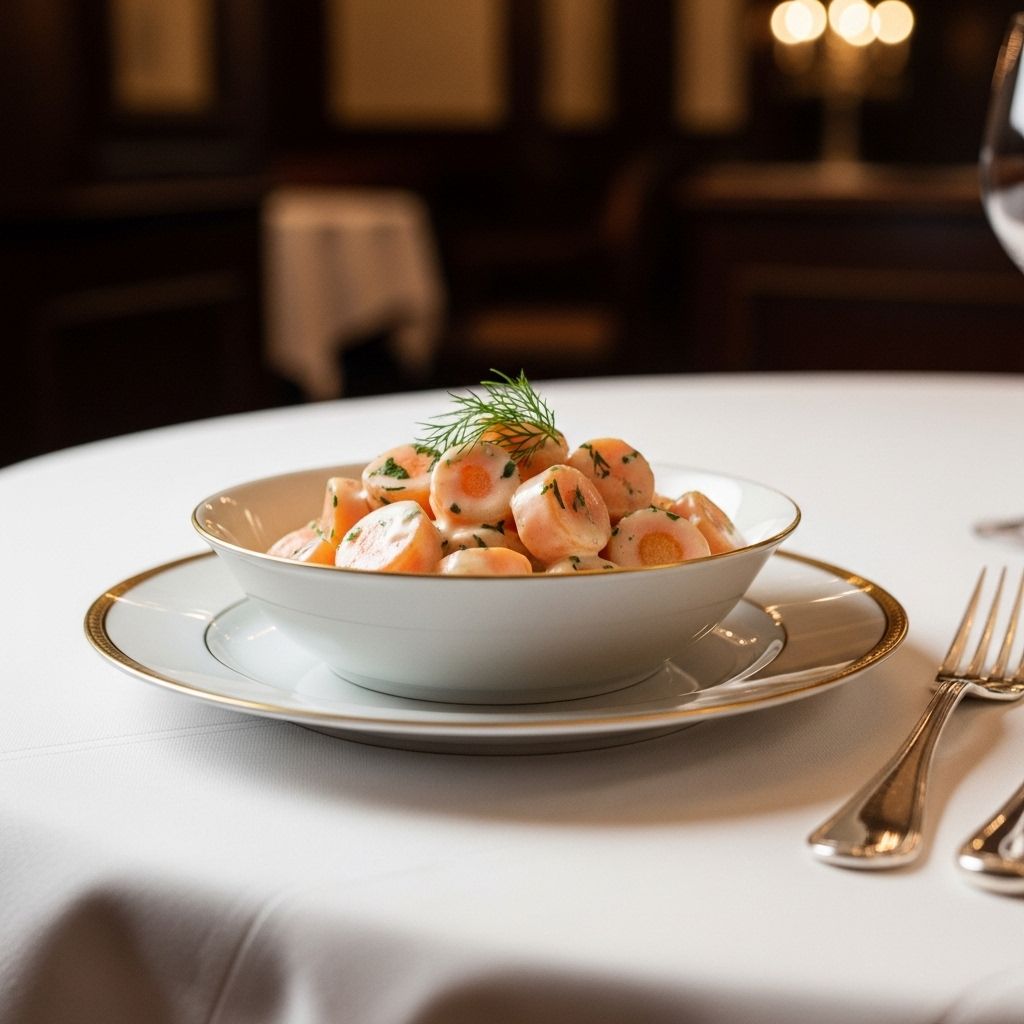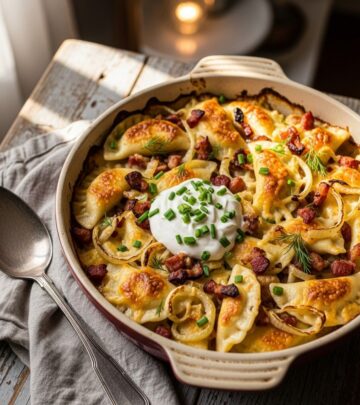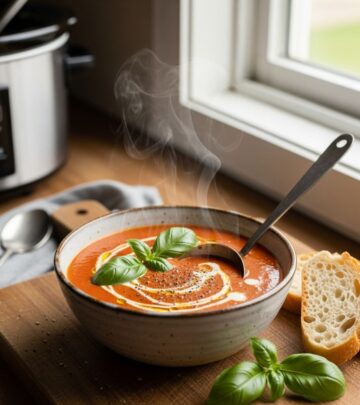Creamed Carrots: A Titanic First-Class Delight
Experience Edwardian elegance with authentic creamed carrots, served aboard the Titanic and rooted in classic French culinary tradition.

Step into a bygone era of opulent transatlantic travel and Edwardian luxury with creamed carrots, a side dish that graced the tables of Titanic’s first-class dining saloon. More than just a humble vegetable preparation, this dish epitomizes the careful detail and refined tastes that defined the Titanic’s legendary final meal in April 1912. With its roots embedded in classic French cooking and Victorian sensibility, creamed carrots take center stage as both a historically significant and delicious feature of vintage cuisine.
Table of Contents
- Historical Context: Dining Aboard the Titanic
- Culinary Origins and Edwardian Influence
- Authentic Titanic-Style Creamed Carrots Recipe
- A Modern Twist: Flavor Variations and Tips
- Nutritional Information
- Pairings and Serving Suggestions
- Legacy, Popularity, and Frequently Asked Questions
Historical Context: Dining Aboard the Titanic
The RMS Titanic was not just a marvel of maritime engineering—it was a floating palace, renowned for its unparalleled refinement and extravagant meals. Dining experiences, especially in first class, were crafted to rival the grandest hotels and restaurants in Europe, with menus reflecting the finest trends of 1910s society. On the night of April 14, 1912, first-class passengers enjoyed an exquisite multi-course dinner, including classics like poached salmon, lamb with mint sauce, chateau potatoes, and notably, creamed carrots .
Carrots, typically a modest root vegetable, were transformed through French technique and rich dairy components, offering a luxurious counterpart to roasted meats and refined entrees. These types of vegetable dishes reflected both the culinary sophistication and the desire of the Edwardian elite to elevate even the simplest of ingredients.
Culinary Origins and Edwardian Influence
The recipe for creamed carrots served aboard the Titanic was rooted in classic French culinary methods, in keeping with the broader gastronomic influences of the era. Creamed vegetables—peas, onions, potatoes, spinach, and carrots—were staples in fine dining rooms across England and France. A classic roux (a cooked mixture of butter and flour) forms the base, gently thickened with whole milk and cream, and delicately flavored with spices like nutmeg and white pepper .
Cookbooks from the period, such as those by Mrs. Beeton and Escoffier, inspired shipboard chefs. Carrots, either cut into generous rounds or elegant julienne sticks, were simmered to retain both their sweetness and subtle firmness, ensuring a pleasing texture for the sophisticated palate.
Authentic Titanic-Style Creamed Carrots Recipe
This section details a carefully reconstructed recipe, faithfully aligned with historical sources and modern adaptations.
Ingredients
- 8-9 medium carrots (peeled and sliced into 1/4-inch rounds or julienned)
- 1 cinnamon stick (optional, for subtle spice)
- 1–2 tablespoons unsalted butter (for roux)
- 1 tablespoon all-purpose flour
- 1/2 teaspoon salt
- 1/4 teaspoon ground white pepper
- 1/4 teaspoon nutmeg (freshly grated preferred)
- 1/3 cup heavy cream
- 1/2 cup whole milk
- 1/2 teaspoon granulated sugar
- 1 teaspoon lemon juice (for brightness)
- 2 tablespoons fresh parsley or chives, finely chopped (for garnish)
Method
- Prepare the Carrots:
- Peel and slice the carrots into rounds, about 1/4-inch thick, or julienne them for a refined presentation.
- Place in a saucepan and cover with water. Add the cinnamon stick for a gentle undernote.
- Bring to a boil, then reduce to medium-high heat. Cook for 6–10 minutes, or until just fork-tender—not mushy.
- Drain well, discard the cinnamon stick, and set carrots aside.
- Make the Cream Sauce (Roux):
- In a medium saucepan, melt the butter over medium heat. Stir in flour and cook for 1–2 minutes, being careful not to brown.
- Slowly whisk in the milk and heavy cream. Keep whisking until the sauce thickens and is velvety smooth—about 3–4 minutes.
- Season with remaining salt, white pepper, nutmeg, and sugar. Add lemon juice for balance. Taste and adjust seasoning as needed.
- Combine and Serve:
- Add the drained carrots to the cream sauce, stirring gently to coat. Cook for another 2–3 minutes so flavors meld.
- Transfer to a shallow serving dish and garnish with chopped parsley or chives.
- Serve warm as a refined accompaniment to main courses.
Cook’s Tips
- Don’t overcook the carrots—they should remain tender yet retain some texture.
- For deeper flavor, infuse the milk with a bay leaf or additional spices while heating.
- Always use fresh cream and high-quality butter for best results.
A Modern Twist: Flavor Variations and Tips
While the original Titanic recipe adheres to simplicity and subtlety, modern cooks can experiment with additional flavors while still celebrating the dish’s elegance.
- Infuse with herbs: Add a sprig of fresh thyme or dill to the sauce for a fresh note.
- Zest of lemon or orange: Brightens flavor and complements carrot sweetness.
- Nut alternatives: Toasted slivered almonds can be sprinkled on top for extra texture and visual appeal.
- For added depth, a pinch of smoked paprika or cayenne introduces a subtle complexity without overpowering the creaminess.
Nutritional Information
Creamed carrots are undeniably lush, thanks to the cream and butter base. While not a light dish by modern standards, it offers legitimate nutritional value, especially from the carrots’ vitamins and fiber.
| Nutrient | Amount (per serving) |
|---|---|
| Calories | 978 |
| Total Fat | 73.1 g (94% DV) |
| Saturated Fat | 42.8 g (214% DV) |
| Cholesterol | 211 mg (70% DV) |
| Sodium | 2842 mg (124% DV) |
| Total Carbohydrate | 63.9 g (23% DV) |
| Dietary Fiber | 14.2 g (51% DV) |
| Total Sugars | 39.6 g |
| Protein | 12.9 g (26% DV) |
| Vitamin D | 2.7 mcg (13% DV) |
| Calcium | 474 mg (36% DV) |
| Iron | 1.6 mg (9% DV) |
| Potassium | 1982 mg (42% DV) |
*Percent Daily Values (DV) are based on a 2,000 calorie diet.
Pairings and Serving Suggestions
To fully evoke Titanic’s first-class experience, serve creamed carrots alongside dishes common to Edwardian banquet tables. Below are recommended pairings and tips for presentation:
- Roast lamb with mint sauce – The fresh, clean notes of mint complement the sweetness of the creamed carrots.
- Calvados-glazed duckling – Rich, gamey duck contrasts beautifully with the mild, creamy carrots.
- Chateau potatoes or minted pea timbales – For a sumptuous period-appropriate side ensemble.
- First-class wine selections: Pair with a light-bodied white Burgundy or an off-dry Riesling to offset the creaminess.
- Garnishing: Use a shallow bowl, scatter chopped chives or parsley, and consider ornate silver serving ware to heighten the sense of occasion.
Legacy, Popularity, and Frequently Asked Questions
Creamed carrots have persisted as a beloved comfort food, not only associated with Titanic’s final first-class meal, but also representing a broader tradition of classic French and English home cooking. The recipe’s continued popularity at commemorative Titanic dinners and historical events speaks to its enduring appeal.
Frequently Asked Questions (FAQs)
What makes Titanic’s creamed carrots unique?
Titanic’s version is distinguished by its luxurious cream sauce, use of subtle warm spices like nutmeg and cinnamon, and an emphasis on precise texture—a product of both Old World culinary tradition and first-class luxury .
Were creamed carrots only served in first class?
Historical records indicate creamed carrots appeared on the first-class dinner menu as part of the “Removes”—the course between entrees and sorbet . Other classes had simpler preparations. First-class diners enjoyed a version with more expensive dairy, fresh spices, and elaborate presentation.
How closely does this recipe resemble the original?
This reconstruction relies on primary sources—menus and period cookbooks—combined with modern adaptations for technique and taste. The essence, flavor profile, and presentation remain true to the Titanic era .
Is this dish suitable for modern tastes?
Yes. Despite its richness, the dish offers a nostalgic and accessible way to experience history. Modern versions tend to reduce the cooking time for a fresher, lighter carrot texture compared to the Victorian tradition of extended boiling.
Can I make this recipe vegetarian or lighter?
Absolutely. Use plant-based substitutes for butter and cream, and consider coconut or oat milk for a comparable texture. Reduce salt and omit sugar if preferred. The base can be customized for both health and dietary needs—just keep the essence and gentle warming spices.
How do I achieve the perfect cream sauce?
- Cook the roux briefly—no browning for a pale, silky finish.
- Whisk thoroughly when adding milk and cream to avoid lumps.
- Season at the end, as reducing the sauce will intensify flavors.
A Taste of Titanic at Home
There are few culinary experiences that bridge history and taste as elegantly as preparing the creamed carrots of the Titanic. Replete with creamy texture, a hint of sweet earthiness, and the gentle perfume of nutmeg, this side dish is an invitation to dine as Edwardian gentry—whether at an elaborate gathering or a simple family meal. Recreating such recipes not only preserves history, but also serves as a reminder of the timeless pleasures found in elevating everyday ingredients.
Recipe Card: Creamed Carrots from Titanic
| Prep Time | 10 minutes |
|---|---|
| Cook Time | 20 minutes |
| Servings | 6 |
- Carrot preparation: Peel, cut, and boil until tender, then set aside.
- Sauce creation: Prepare butter-flour roux, add cream and milk, cook until thickened, then season.
- Combine: Fold cooked carrots into the sauce, heat through, garnish, and serve.
Original Titanic First-Class Menu Excerpt:
- Canapés à l’Amiral
- Consommé Olga
- Poached Salmon with Mousseline Sauce
- Chicken Lyonnaise
- Filets Mignons Lili
- Creamed Carrots
- Chateau Potatoes
- Minted Green Pea Timbales
These dishes, served as part of an 11-course dinner, reflected the cosmopolitan luxury and celebratory spirit that defined RMS Titanic’s place in history.
Further Reading
- Last Dinner on the Titanic: Menus and Recipes from the Great Liner (primary source for Titanic culinary details)
- Mrs. Beeton’s Book of Household Management (key Victorian recipe reference)
- See Pairings and Serving Suggestions above for a full period menu.
Read full bio of Sneha Tete












